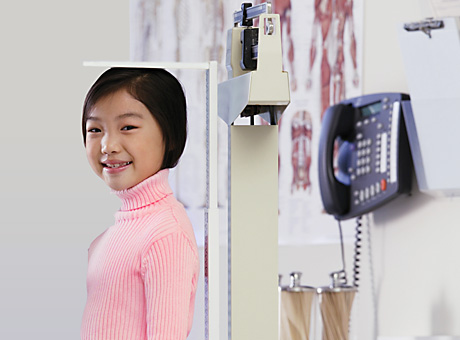
Pediatric asthma specialists at St. Louis Children’s Hospital keep a close watch on the growth of their patients.

Pediatric asthma specialists at St. Louis Children’s Hospital keep a close watch on the growth of their patients.
Children who use inhaled steroids for asthma end up slightly shorter at their full adult height than children who don’t use the drugs, new results from a comprehensive asthma study show.
The findings were published online on Sept. 3, 2012, in the New England Journal of Medicine. The study’s senior author is Robert C. Strunk, MD, the Donald Strominger Professor of Pediatrics.
The study involved more than 1,000 children ages five to 12 who were treated for mild to moderate asthma as part of the Childhood Asthma Management Program (CAMP) clinical trial. The children received treatment for more than four years at eight centers, including Washington University School of Medicine.
Study participants were divided into three groups: one received twice-daily budesonide, an inhaled corticosteroid medication; a second group received nedocromil, an inhaled non-steroid medication; and a third group received a placebo. All children received albuterol, a fast-acting drug for relief of acute asthma symptoms, and oral corticosteroids as needed for asthma symptoms.
Children who use inhaled steroids for asthma end up slightly shorter at their full adult height than children who don’t use the drugs.
The researchers followed 943 participants at regular intervals until they reached adult height (females, age 18; males, age 20). The mean adult height was about one-half inch, or 1.2 centimeters, shorter in the group that received budesonide than in the patients who received nedocromil or a placebo. The patients who experienced the slower growth were primarily between five to 11 years old when they began using budesonide.
The slower growth took place only in the first two years of the four-year study. As the study progressed, the children who took the budesonide remained one-half inch shorter through adulthood than those who did not.
“This was surprising because in previous studies, we found that the slower growth was temporary, not affecting adult height,” says Strunk, who treats children with asthma at St. Louis Children’s Hospital. “But none of those studies followed patients from the time they entered the study until they had reached adult height.”
Strunk, the CAMP study chair, says researchers considered other factors that also might have contributed to the slower growth rate, but found these to have no impact.
“If a child is not growing as they should, we may reduce their steroid dose,” he says. “But that half-inch of lowered adult height must be balanced against the well-established benefit of inhaled corticosteroids in controlling persistent asthma.”
NIH NIHLBI/GCRC N01-HR-16044, ET AL